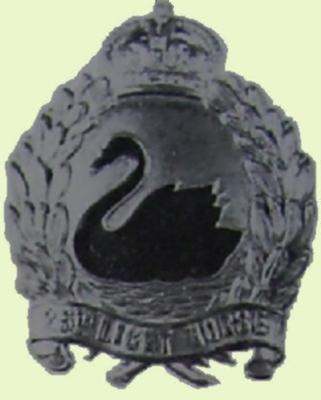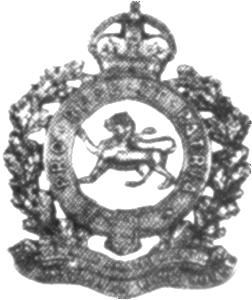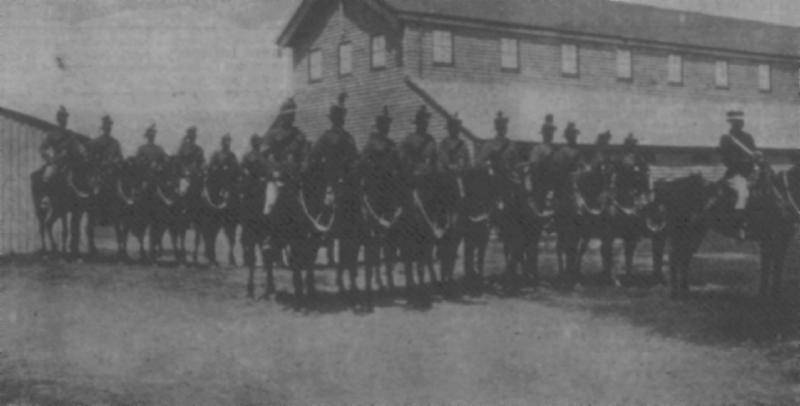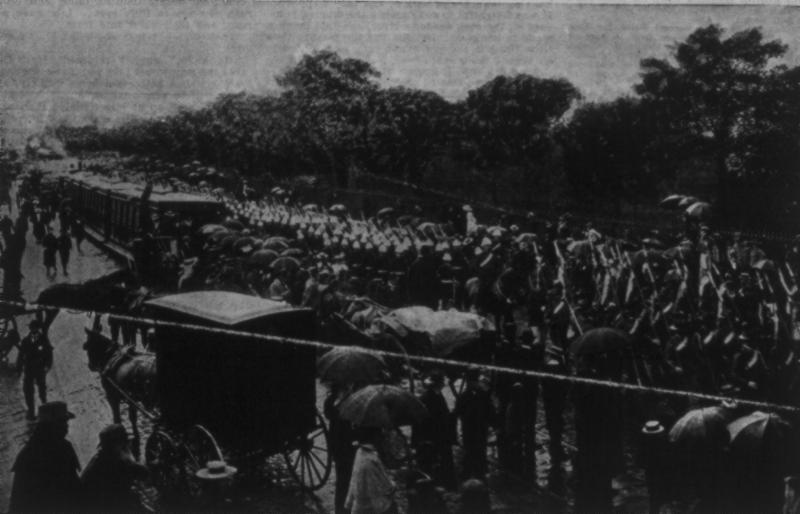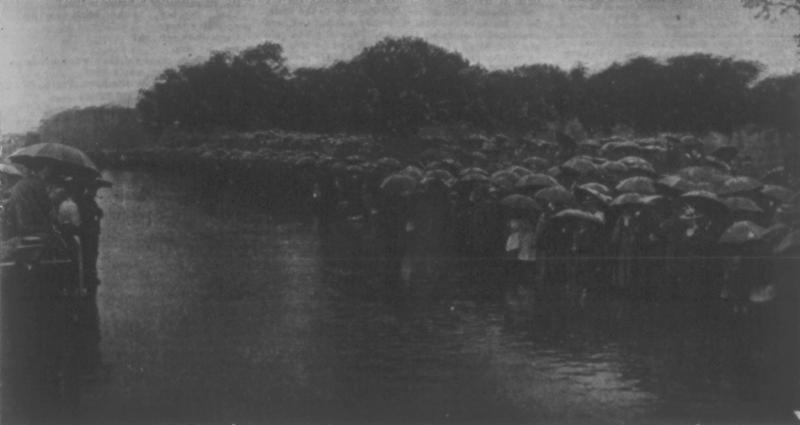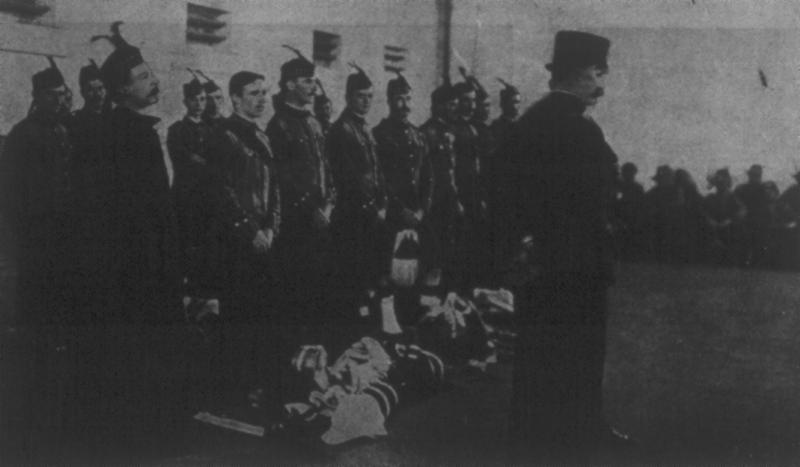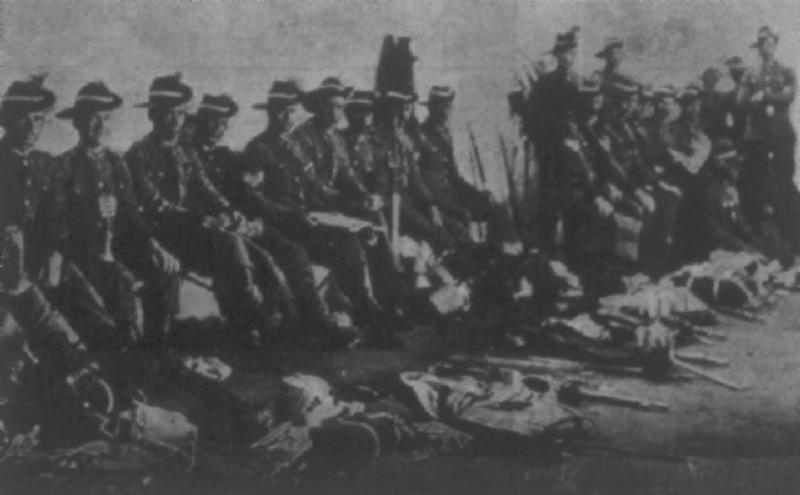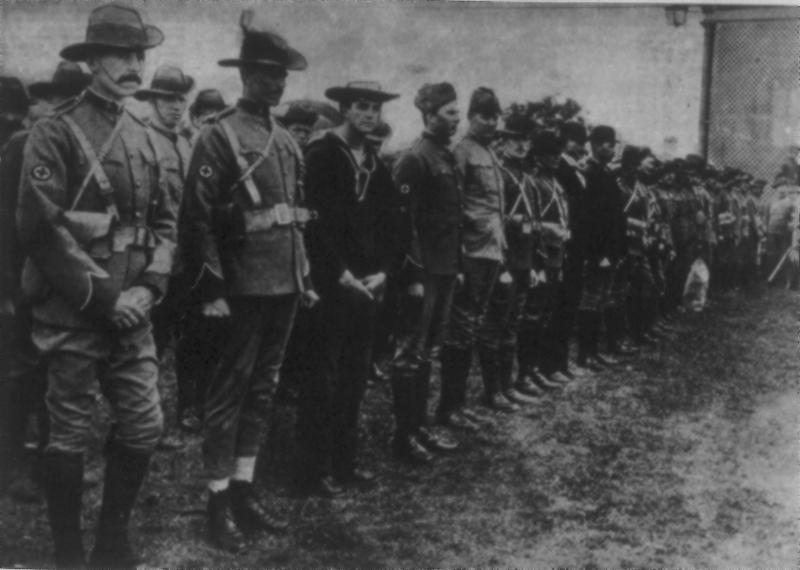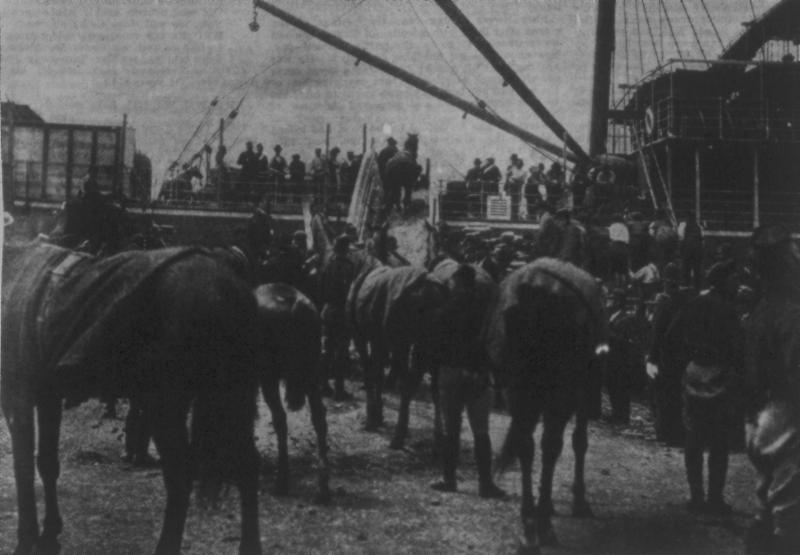Topic: BW - Boer War
South African (Second Boer) War, 1899 - 1902
Australian Forces
Roll of Honour
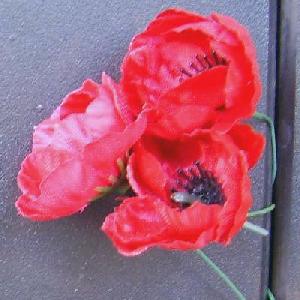
Poppies on the Roll of Honour, Australian War Memorial, Canberra
The Roll of Honour contains the names of all the men known to have served at one time with the various Australian forces and gave their lives in service of Australia, whether as part of the their original unit or another unit during the Boer War.
Roll of Honour
Alexander McFarlane ABERLINE, New South Wales Imperial Bushmen, "F" Company.
William John ABRAHAMS, New South Wales Mounted Rifles, "A" Squadron.
Francis Thomas ADAM, 6th West Australian Mounted Infantry.
Sydney AHRENS, 2nd New South Wales Mounted Rifles.
Robert ALDAY, 5th West Australian Mounted Infantry.
Alfred Edward Elkington ALLEN, New South Wales Mounted Rifles, "A" Squadron.
Alfred John ALLINGHAM, 3rd New South Wales Mounted Rifles, "B" Squadron.
John ANDERSON, 7th Australian Commonwealth Horse, "A" Squadron, Queensland.
John Henry ANDERSON, 5th Queensland Imperial Bushmen.
John Alexander Stewart ANDREW, 1st Australian Horse, New South Wales.
Frank ANDREWS, New South Wales Imperial Bushmen, Headquarters.
Thomas Hotspur ANGEL, 3rd West Australian Imperial Bushmen.
James Whamond ANNAT, 3rd Queensland Mounted Infantry.
John Harry ANNING, 5th Queensland Imperial Bushmen.
Aubrey Vincent APTHORPE, 3rd New South Wales Mounted Rifles, "A" Squadron.
Douglas James ARNDELL, 3rd New South Wales Imperial Bushmen.
Samuel Charles ATCHISON, 1st New South Wales Mounted Rifles, "E" Squadron; 1st Australian Regiment.
Marmaduke W ATKINSON, 1st Victorian Mounted Infantry.
Frederick AVARD, New South Wales Lancers.
William Myles AYRE, New South Wales Citizens Bushmen, "B" Squadron.
Arthur Thomas BAILEY, 3rd Queensland Mounted Infantry.
Elliot Henry BAILEY, 1st Tasmanian Mounted Infantry Contingent.
William Samuel BARBER, 4th Battalion Australian Commonwealth Horse, S Aust.
Robert BARBOUR, 1st Victorian Mounted Infantry.
Thomas Percy BARKER, 2nd New South Wales Mounted Rifles.
Thomas William BARKER, 1st Tasmanian Mounted Infantry Contingent.
Stanley John BARNARD, 5th Victorian Mounted Rifles.
Dennis Joseph BARRETT, New South Wales Citizens Bushmen, "D" Squadron.
Robert Thomas BARRON, 5th and 6th South Australian Imperial Contingents.
Francis BARTLETT, 2nd South Australian Mounted Rifles.
Edward Percy BARTON, 7th Australian Commonwealth Horse, "B" Squadron, Queensland.
Carl Oswald BASCHE, 1st New South Wales Mounted Rifles, "B" Squadron.
Michael BASTICK, 2nd New South Wales Mounted Rifles.
Edwin Charles Matthew BAWDEN, 4th Victorian Imperial Bushmen.
Harry Monsell BAYLISS, 3rd New South Wales Mounted Rifles, "A" Squadron.
Harold Egbert BEARE, 6th South Australian Imperial Contingent.
Henry Saint-John BEASLEY, 3rd New South Wales Mounted Rifles, "D" Squadron.
Anders Gustav BELIN, 5th Queensland Imperial Bushmen.
John Leo BELLAMY, 3rd New South Wales Imperial Bushmen.
William BENDER, New South Wales Mounted Rifles, "A" Squadron.
Arthur Thomas BENNETT, New South Wales Mounted Rifles, "A" Squadron.
Henry Augustus BENNETT, New South Wales Imperial Bushmen, "E" Company.
Alfred James BENNIER, 5th and 6th South Australian Imperial Contingents.
William Thomas BERRIMAN, 3rd New South Wales Mounted Rifles, "B" Squadron.
Robert Edwin BERRY, 5th Queensland Imperial Bushmen.
Henry Allwright BETTS, 1st Tasmanian Mounted Infantry Contingent.
Isaac BEWLEY, 3rd New South Wales Mounted Rifles, "E" Squadron.
John Wright BIDDLE, 1st New South Wales Mounted Rifles, "B" Squadron.
George Neville BISHOP, 1st West Australian Mounted Infantry.
David BLACK, New South Wales Imperial Bushmen, "D" Company.
Hector Norman BLACK, 3rd New South Wales Imperial Bushmen.
Henry Mitchell BLACK, 1st Tasmanian Mounted Infantry Contingent.
Arthur BLANCK, 6th West Australian Mounted Infantry.
Ernest Henry BLANDFORD, 5th Victorian Mounted Rifles.
Frederick Gregg BLUNT, 5th Queensland Imperial Bushmen.
George William BOLDING, 3rd Victorian Imperial Bushmen.
William Frederick BOLLINGER, 5th West Australian Mounted Infantry.
Louis BOND, 5th Victorian Mounted Rifles.
William Thomas BONNER, 1st Australian Horse, New South Wales.
Arthur Clinton BOURKE, 4th Queensland Imperial Bushmen.
Henry John BOXALL, 5th Victorian Mounted Rifles.
Reginald Stephen Robert Stapylton BREE, 2nd Victorian Mounted Rifles.
Herbert BRENT, 3rd Victorian Imperial Bushmen.
George Edwin BRISTOW, 2nd Victorian Mounted Rifles.
Edmund St John Vincent BRODRICK, 1st Queensland Mounted Infantry.
Arthur BROWN, 2nd New South Wales Mounted Rifles.
Godfrey Hugh BROWN, 3rd Tasmanian Imperial Bushmen.
William Alexander BROWNLEY, 8th Battalion Australian Commonwealth Horse, S Aust.
William Henry BRYCE, 1st Queensland Mounted Infantry.
Alfred George Kernan BUCKINGHAM, 5th Victorian Mounted Rifles.
Henry Martin BUDD, 1st Australian Regiment New South Wales.
Albert Edward BURLEY, 5th Victorian Mounted Rifles.
George Herbert BURNS, 3rd New South Wales Imperial Bushmen.
Joseph BUTLER, 1st Tasmanian Mounted Infantry Contingent.
William BUTLER, 4th Queensland Imperial Bushmen.
Alfred BUTTON, 1st Tasmanian Mounted Infantry Contingent.
George Rowland BUTTON, 5th Victorian Mounted Rifles.
Archibald Lochiel CAMERON, 1st New South Wales Mounted Rifles, "E" Squadron; 1st Australian Regiment New South Wales.
Norman Victor CAMERON, 3rd New South Wales Mounted Rifles, "E" Squadron.
Robert CAMERON, New South Wales Citizens Bushmen, "C" Squadron.
Andrew McKenzie CAMPBELL, 3rd New South Wales Mounted Rifles, "E" Squadron.
Robert B CAMPBELL, 1st New South Wales Mounted Rifles, "C" Squadron.
Lachlan John CASKEY, 5th Queensland Imperial Bushmen.
F H CAUGHEY, 5th Victorian Mounted Rifles.
Matthew CEANEY, 6th Queensland Imperial Bushmen.
George CHALLIS, New South Wales Imperial Bushmen, "B" Company.
Charles CHARDON, 5th Queensland Imperial Bushmen.
John CHARLTON, 5th Victorian Mounted Rifles.
Edward Brown CHESHER, New South Wales Citizens Bushmen, "C" Squadron.
Alexander John Henry CHISHOLM, 3rd New South Wales Mounted Rifles, Machine Gun Section.
John George CHRISP, 5th Victorian Mounted Rifles.
James William CHRISTIE, 3rd Victorian Imperial Bushmen.
Peter James CLANCY, 4th Queensland Imperial Bushmen.
William Edward CLANCY, 2nd New South Wales Mounted Rifles.
George Howard CLARK, 5th Queensland Imperial Bushmen.
Walter Ernest CLARK, 2nd Victorian Mounted Rifles.
William George CLARKE, 5th Queensland Imperial Bushmen.
Clarence Chudleigh CLIFFORD, 6th West Australian Mounted Infantry.
John William CLOUGH, 3rd New South Wales Imperial Bushmen.
Bertram H COCHRANE, 5th and 6th South Australian Imperial Contingents.
Murray William COLLETT, 1st West Australian Mounted Infantry.
James COLLINS, 5th Victorian Mounted Rifles.
Michael Joseph COMMINS, 1st Australian Horse, New South Wales.
George Bertram CONLEY, 1st Queensland Mounted Infantry.
Michael CONWAY, 1st West Australian Mounted Infantry.
Edwin Jas CONYBEARE, 1st New South Wales Mounted Rifles, "B" Squadron.
Granville Thomas COOPER, New South Wales Citizens Bushmen, Headquarters.
John COSTELLO, 5th Victorian Mounted Rifles.
Arthur Edward COULSON, 1st Australian Regiment, Victoria.
Sydney Richard COULTER, 5th Victorian Mounted Rifles.
John COUSINS, 5th Queensland Imperial Bushmen.
Francis Gilbert COWELL, 4th Tasmanian Contingent, 2nd Imperial Bushmen.
Reginald Belmore COX, 1st Australian Horse, New South Wales.
George Francis COYLE, 2nd New South Wales Mounted Rifles.
Charles CRAWFORD, 3rd New South Wales Imperial Bushmen.
William John CREELMAN, 4th Victorian Imperial Bushmen.
Thomas Wentworth CRESSY, New South Wales Imperial Bushmen, "B" Company.
David Ross CRICHTON, 2nd New South Wales Mounted Rifles.
John Wyllie CRIGHTON, 4th Victorian Imperial Bushmen.
Charles G CRIPPS, 1st New South Wales Mounted Rifles, "B" Squadron.
Frederick George CROFT, 5th and 6th South Australian Imperial Contingents.
Edward CRONAN, 2nd Queensland Mounted Infantry.
W CROOM, 1st Battalion Australian Commonwealth Horse.
George James CULLEN, 2nd Victorian Mounted Rifles.
Ralph CUMMING, 3rd New South Wales Mounted Rifles, "E" Squadron.
Robert Ross CUMMING, 5th Queensland Imperial Bushmen.
William Jospeh CUMMINGS, New South Wales Citizens Bushmen Contingent.
Thomas CUMNER, 1st Queensland Mounted Infantry.
Charles CUNDY, 3rd Battalion Australian Commonwealth Horse, Tasmanian.
C W B CURRIE, 3rd South Australian Bushmen.
Edward DAGGAR, New South Wales Imperial Bushmen, "C" Company.
Joseph DALEY, 3rd New South Wales Mounted Rifles, "C" Squadron.
James George DALLISTON, 5th West Australian Mounted Infantry.
Verdi Robert DALY, New South Wales Mounted Rifles, "A" Squadron.
William Alexander DAMROW, 1st Queensland Mounted Infantry.
Albert Benjamin DAVIDSON, 5th Victorian Mounted Rifles.
George William DAVIDSON, New South Wales Citizens Bushmen, "D" Squadron.
Albert William DAVIS, 6th Queensland Imperial Bushmen.
Cornelius George DAVIS, 4th South Australian Imperial Bushmen.
George DAWS, 4th Queensland Imperial Bushmen.
James DELAHUNTY, 6th West Australian Mounted Infantry.
William DEVITT, 1st Queensland Mounted Infantry.
George Jennings DICKSON, 3rd New South Wales Mounted Rifles, "C" Squadron.
Robert Percy DOOLIN, 1st Tasmanian Mounted Infantry Contingent.
Frederick George DOW, 5th Victorian Mounted Rifles.
James Stirling DOWNES, 3rd New South Wales Imperial Bushmen.
Percy William Chanter DRAGE, 1st New South Wales Mounted Rifles, "D" Squadron.
Harold DRINKWATER, New South Wales Citizens Bushmen, "C" Squadron.
Patrick J DRUM, 1st New South Wales Mounted Rifles, "D" Squadron.
S W DUDLEY, 6th Battalion Australian Commonwealth Horse, Vic.
James Daniel DUFF, New South Wales Citizens Bushmen, "A" Squadron.
Walter DUGDALE, 7th Australian Commonwealth Horse, "A" Squadron, Queensland.
James DUGGAN, 4th Queensland Imperial Bushmen.
William John DUNSTAN, 5th West Australian Mounted Infantry.
Alexander William EAGLETON, 5th Queensland Imperial Bushmen.
Alfred EBSWORTH, 1st Australian Horse, New South Wales.
George Albert EDDY, 1st Australian Regiment, Victoria.
Frederick Francis EDWARDS, 5th West Australian Mounted Infantry.
Walter EDWARDS, A Battery Royal Australian Artillery.
Walter Melrose ELLIS, New South Wales Lancers.
William Reynolds EWENS, 6th South Australian Imperial Contingent.
James Joseph FAHEY, New South Wales Imperial Bushmen, "F" Company.
James FANTON, 1st New South Wales Mounted Rifles, "B" Squadron.
Martin FARRELL, 2nd New South Wales Mounted Rifles.
Franz Gustav A L FETTING, New South Wales Lancers.
James FINNIGAN, New South Wales Citizens Bushmen, "C" Squadron.
Benjamin FISHER, 6th West Australian Mounted Infantry.
Albert Edward FITZALLEN, 1st Battalion Australian Commonwealth Horse, Tas, 1/2 Coy.
Clive FLINT, New South Wales Mounted Rifles, "A" Squadron.
Thomas FLINT, 6th Queensland Imperial Bushmen.
Robert FORAN, 2nd New South Wales Mounted Rifles.
Harold FORCE, 1st West Australian Mounted Infantry.
John Francis FOREMAN, 2nd New South Wales Mounted Rifles.
Anthony Alexander FORREST, 5th West Australian Mounted Infantry.
George Brooke FORSTER, 2nd New South Wales Mounted Rifles.
George Given FORSYTH, 5th Queensland Imperial Bushmen.
Thomas Barham FOSTER, 4th Victorian Imperial Bushmen.
George William FRANCIS, 2nd Victorian Mounted Rifles.
Donald FRASER, 1st Australian Regiment New South Wales.
Donald FRASER, 1st New South Wales Mounted Rifles, "E" Squadron.
Donald FRASER, New South Wales Citizens Bushmen, "A" Squadron.
John Clarence FRASER, 1st New South Wales Mounted Rifles, "E" Squadron.
William FRASER, 4th West Australian Mounted Infantry.
William FREEMAN, 1st New South Wales Mounted Rifles, "D" Squadron.
Oliver Edwin FRY, 6th West Australian Mounted Infantry.
Thomas A FULTON, 1st New South Wales Mounted Rifles, "C" Squadron.
Richard Joseph FURLONG, 5th West Australian Mounted Infantry.
Thomas GALVIN, 1st Tasmanian Mounted Infantry Contingent.
George GANDER, 3rd New South Wales Mounted Rifles, "D" Squadron.
Frederick James GARDINER, New South Wales Imperial Bushmen Contingent, serving with ASC.
Edward GAY, 3rd New South Wales Imperial Bushmen.
David Haxton GIBB, 5th and 6th South Australian Imperial Contingents.
George Henry Flood GIBSON, New South Wales Citizens Bushmen, "A" Squadron.
Charles Anthony GILCHRIST, 1st Australian Regiment New South Wales.
Horace William GILCHRIST, 1st Australian Horse, New South Wales.
Atherly GILHAM, 1st Tasmanian Mounted Infantry Contingent.
Alex George GILPIN, 4th Victorian Imperial Bushmen.
Carlyon GLINN, 5th Victorian Mounted Rifles.
John Edgar GLUYAS, 5th and 6th South Australian Imperial Contingents.
Charles John GOEBEL, 4th Victorian Imperial Bushmen.
Frederick Thomas GOODALL, 5th Queensland Imperial Bushmen.
Herbert Ernest GOODES, 4th South Australian Imperial Bushmen.
Herbert John GOODMAN, 3rd Victorian Imperial Bushmen.
Isaac GOODSELL, Army Medical Corps.
Jerome Theige GORMAN, 6th Queensland Imperial Bushmen.
Charles John GOSPER, 3rd New South Wales Mounted Rifles, "C" Squadron.
Laurence James Watt GOUDIE, 5th Victorian Mounted Rifles.
Bernard GOWING, A Battery Royal Australian Artillery.
Neil GRANT, 1st Australian Regiment, Victoria.
James Mackey GRAY, 3rd New South Wales Mounted Rifles, Drafts.
Ernest William GREEN, 2nd New South Wales Mounted Rifles.
John GREEN, 1st Battalion Australian Commonwealth Horse.
Arthur Percy Briton GREY, New South Wales Citizens Bushmen, "A" Squadron.
Gidgeon James GRIEVE, Special Service Officers, attached to 2nd The Black Watch.
George Allman GRIFFEN, 1st Australian Horse, New South Wales.
Harry HADLEY, 5th Victorian Mounted Rifles.
Belton Andrew HALLEY, 1st New South Wales Mounted Rifles, "E" Squadron.
Edgar Anthony HAMBLY, 3rd West Australian Imperial Bushmen.
James HAMILTON, 5th and 6th South Australian Imperial Contingents.
Arthur HAMMOND, 5th West Australian Mounted Infantry.
Richard Frank HAMP, 5th and 6th South Australian Imperial Contingents.
Hugh Hunter HANDCOCK, New South Wales Imperial Bushmen, "C" Company.
George Lawrence HARDY, 2nd South Australian Mounted Rifles.
Henry Cullum HARDY, New South Wales Imperial Bushmen, "A" Company.
Walter HARKER, 2nd New South Wales Mounted Rifles.
Rowland Edward HARKUS, New South Wales Lancers.
Thomas HARLAND, 3rd Battalion Australian Commonwealth Horse.
William Rupert HARRIOTT, 1st New South Wales Mounted Rifles, "C" Squadron.
Thomas William HARRIS, 2nd Battalion Australian Commonwealth Horse.
Henry HARRISON, 5th Victorian Mounted Rifles.
Joseph HARRISON, Army Medical Corps 2nd Contingent.
Robert Glenn HARRISON, 5th Victorian Mounted Rifles.
Peter Stewart HASTIE, 4th Queensland Imperial Bushmen.
James Thomas HAY, 2nd New South Wales Mounted Rifles.
William James HEALY, 5th Victorian Mounted Rifles.
J H HEINJUS, 1st South Australian Mounted Rifles.
John Oliver HELDER, 4th Queensland Imperial Bushmen.
William Muir HENDRY, 5th Queensland Imperial Bushmen.
Herbert Henry HENDY, 5th Victorian Mounted Rifles.
Geoffrey Gordon William HENSMAN, 1st West Australian Mounted Infantry.
Geoffrey Gordon William HENSMAN, 1st West Australian Mounted Infantry.
John Smith HESKETH, 4th Victorian Imperial Bushmen.
Herbert Vincent HEWINS, 5th Victorian Mounted Rifles.
Leslie Charles HILL, 1st New South Wales Mounted Rifles, "E" Squadron.
Frances Emma HINES, Nursing Service.
Malcolm George Patrick HIPWELL, 5th and 6th South Australian Imperial Contingents.
Frederick William HIRTH, 5th and 6th South Australian Imperial Contingents.
Henry James HISCOCK, 2nd Victorian Mounted Rifles.
Vincent Lade HODGMAN, 3rd Battalion Australian Commonwealth Horse, Tasmanian.
William Fleming HOPKINS, 1st Australian Regiment (Medical Staff), Vic.
Charles Forbes HORNER, 4th South Australian Imperial Bushmen.
Nathaniel HORSFALL, 5th and 6th South Australian Imperial Contingents.
Albert HOUGHTON, 5th Victorian Mounted Rifles.
John Francis HOULIHAN, 5th Victorian Mounted Rifles.
Samuel Grau HUBBE, 3rd South Australian Bushmen.
George HULL, 3rd Queensland Mounted Infantry.
James HUME, 3rd West Australian Imperial Bushmen.
Archibald HUMPHRIES, 1st Battalion Australian Commonwealth Horse, Queensland.
Edward Henry HUNT, 5th Queensland Imperial Bushmen.
Robert Thomas HUNTER, 6th West Australian Mounted Infantry.
John Stephen HURST, 4th Victorian Imperial Bushmen.
Leonard Percy HUTTLEY, 4th Tasmanian Contingent, 2nd Imperial Bushmen.
James Archibald HYNDMAN, New South Wales Imperial Bushmen, "B" Company.
Ernest George ILES, 4th West Australian Mounted Infantry.
Richard Jeffrey INCH, 3rd New South Wales Imperial Bushmen.
William Charles JACKSON, 3rd New South Wales Mounted Rifles, "C" Squadron.
James Henry JACOBS, 3rd New South Wales Mounted Rifles, "C" Squadron.
Edward Roger JACSON, 2nd Tasmanian Imperial Bushmen.
Walter Jospeh JAMES, 1st Australian Horse, New South Wales.
William Walter JAMES, 5th Victorian Mounted Rifles.
Frederick Guin JEFFREYS, 4th Battalion Australian Commonwealth Horse, Vic.
George JOHNSON, 2nd New South Wales Mounted Rifles.
Alfred Gresham JOHNSTON, 5th Victorian Mounted Rifles.
A JONES, 1st Victorian Mounted Infantry.
Hugh Trevor JONES, 3rd New South Wales Mounted Rifles, Drafts.
Victor Stanley JONES, 1st Queensland Mounted Infantry.
Walter JONES, New South Wales Citizens Bushmen, "B" Squadron.
Jephthah JONSON, 4th Victorian Imperial Bushmen.
Ernest Townsend JUCHAN, 6th Queensland Imperial Bushmen.
Alfred KATTING, 1st Battalion Australian Commonwealth Horse, Queensland.
James KAY, 4th West Australian Mounted Infantry.
John KELLY, 5th Victorian Mounted Rifles.
John Joseph KELLY, Army Medical Corps 2nd Contingent.
Robert KELLY, New South Wales Imperial Bushmen, "B" Company.
Robert Shaw KELLY, 5th Queensland Imperial Bushmen.
William Patrick KELLY, 3rd New South Wales Imperial Bushmen.
John KILEY, 4th Victorian Imperial Bushmen.
Frederick Isaac KILPATRICK, New South Wales Lancers.
Reuben KIMPTON, 3rd New South Wales Imperial Bushmen.
Alexander KING, New South Wales Imperial Bushmen, "C" Company.
Oscar David KING, 1st Victorian Mounted Infantry.
Wilfred John KIRKLAND, New South Wales Mounted Rifles, "A" Squadron.
George Harold KITE, 1st New South Wales Mounted Rifles, "B" Squadron.
T J KLAFFER, 1st South Australian Mounted Rifles.
Geroge Henry KNOTT, 2nd Victorian Mounted Rifles.
Edwin KNOX, 3rd Victorian Imperial Bushmen.
Walter Henry KOHLER, 2nd New South Wales Mounted Rifles.
Edward Allister LAMB, 2nd New South Wales Mounted Rifles.
Henry Spencer LAMB, 5th Victorian Mounted Rifles.
James LAMB, New South Wales Citizens Bushmen, "B" Squadron.
Sidney Lutrell LANDSBOROUGH, 2nd Queensland Mounted Infantry.
Sydney LANDSDALE, 4th South Australian Imperial Bushmen.
William Arthur LASSETTER, New South Wales Imperial Bushmen, "D" Company.
John James LAWRENCE, 5th Victorian Mounted Rifles.
John LEASK, 3rd Queensland Mounted Infantry.
Joseph Edward LEFOE, 3rd New South Wales Mounted Rifles, "D" Squadron.
Franklin H LEGGE, 1st New South Wales Mounted Rifles, "C" Squadron.
Thomas B LENNON, 1st New South Wales Mounted Rifles, "C" Squadron.
Herbert William LENON, 3rd New South Wales Mounted Rifles.
Louis Frances John LETTE, 3rd Tasmanian Imperial Bushmen.
William LILLEY, 5th Queensland Imperial Bushmen.
Alfred LINDNER, 3rd New South Wales Imperial Bushmen.
Stanley LIPSCOMBE, New South Wales Imperial Bushmen, "D" Company.
H E LOCKE, 3rd Battalion Australian Commonwealth Horse.
James Miles LOGAN, New South Wales Citizens Bushmen, "A" Squadron.
Walter H LONEY, Army Medical Corps 2nd Contingent.
James William LYND, 4th Queensland Imperial Bushmen.
Douglas M LYNE, 4th Tasmanian Contingent, 2nd Imperial Bushmen.
Warwick MACARTNEY, 5th Queensland Imperial Bushmen.
Charles Edward MACCABE, 4th South Australian Imperial Bushmen.
Douglas Kinneir MACDONALD, 3rd Queensland Mounted Infantry.
John MACFARLANE, 5th Queensland Imperial Bushmen.
William MACFARLANE, 3rd New South Wales Imperial Bushmen.
Archibald Edward MACK, 5th Victorian Mounted Rifles.
George S MACKAY, 1st Battalion Australian Commonwealth Horse, "B" Squadron.
Andrew Ross MACKELLAR, New South Wales Imperial Bushmen, "F" Company.
Keith Kinnaird MACKELLAR, 1st Australian Horse, New South Wales.
Archibald MACKENZIE, 3rd Victorian Imperial Bushmen.
Thomas Henry MAHONEY, 5th Victorian Mounted Rifles.
H G MAIN, 5th and 6th South Australian Imperial Contingents.
John MALCOLM, 6th Queensland Imperial Bushmen.
George MANNS, New South Wales Citizens Bushmen Contingent.
Richard Sydney MARR, 6th Queensland Imperial Bushmen.
Thomas Bradshaw MARSDEN, 2nd South Australian Mounted Rifles.
Albert Edward Charles MARSHALL, 6th South Australian Imperial Contingent.
Edward Sherman MARSHALL, 2nd South Australian Mounted Rifles.
James Edward MASON, 5th Queensland Imperial Bushmen.
Walter MASON, 3rd New South Wales Mounted Rifles, Drafts.
John Thomas MASTERTON, 3rd Queensland Mounted Infantry.
John Ken MATHESON, 6th Queensland Imperial Bushmen.
F G MATTHEWS, 1st South Australian Mounted Rifles.
Alwyne Edward Francis Cornwallis MAUDE, 3rd Queensland Mounted Infantry.
Francis MAXWELL, 4th Queensland Imperial Bushmen.
Bruce Harold MAY, 5th and 6th South Australian Imperial Contingents.
Sydney Selwyn MAYO, 2nd New South Wales Mounted Rifles.
William David MAYS, 4th Victorian Imperial Bushmen.
John Bernard MCCANN, 5th Victorian Mounted Rifles.
John Irwin MCCARTNEY, 3rd Victorian Imperial Bushmen.
Norman MCCAULEY, 3rd New South Wales Mounted Rifles, Drafts.
James MCCLURE, 3rd Victorian Imperial Bushmen.
John MCCORKELL, 5th Victorian Mounted Rifles.
Michael Terence MCDONALD, 3rd Mounted Rifles Contingent, Vic.
Richard Webb MCGILL, 1st New South Wales Mounted Rifles, "B" Squadron.
James MCGILLIVRAY, 5th and 6th South Australian Imperial Contingents.
John MCGOWAN, 2nd Victorian Mounted Rifles.
R MCGREGOR, 6th Battalion Australian Commonwealth Horse.
Robert Henry MCGREGOR, 5th West Australian Mounted Infantry.
George Reginald MCGUINNESS, New South Wales Citizens Bushmen, "A" Squadron.
John MCILVEEN, 5th Queensland Imperial Bushmen.
Thomas MCKAY, 2nd New South Wales Mounted Rifles.
J T MCKENZIE, A Battery Royal Australian Artillery.
William MCKERR, 3rd New South Wales Imperial Bushmen.
Charles MCKINNON, 4th Victorian Imperial Bushmen.
Percy MCLAREN, 3rd Tasmanian Imperial Bushmen.
Simon MCLENNAN, 1st Australian Regiment New South Wales.
Simon MCLENNAN, 1st New South Wales Mounted Rifles, "E" Squadron.
David Cumming MCLEOD, 1st Queensland Mounted Infantry.
Donald John Roderick MCLEOD, 4th Queensland Imperial Bushmen.
John MCNALLY, 5th Victorian Mounted Rifles.
Patrick John MCNAMARA, 3rd New South Wales Imperial Bushmen.
William John MCPHEE, 3rd West Australian Imperial Bushmen.
Neil MCPHERSON, 6th Queensland Imperial Bushmen.
Daniel Peter MEEHAN, New South Wales Citizens Bushmen, "A" Squadron.
William Patrick MEEHAN, 1st Australian Horse, New South Wales.
C J B MERCER, 5th and 6th South Australian Imperial Contingents.
Charles MEREDITH, 4th Queensland Imperial Bushmen.
D F MILLER, 3rd New South Wales Mounted Rifles.
C F MILLMAN, 3rd South Australian Bushmen.
George Henry MILLS, 6th Queensland Imperial Bushmen.
Benjamin MILNER, 5th Queensland Imperial Bushmen.
Edmund Henry MITCHELL, 4th South Australian Imperial Bushmen.
James MITCHELL, New South Wales Citizens Bushmen, "A" Squadron.
Thomas Peter MOHAN, 4th Victorian Imperial Bushmen.
Cuthbert MOLLER, 5th Queensland Imperial Bushmen.
William MONTGOMERIE, 3rd New South Wales Mounted Rifles, "E" Squadron.
George Arthur MONTGOMERY, New South Wales Imperial Bushmen, "A" Company.
Hatherly George MOOR, 1st West Australian Mounted Infantry.
Charles MOORE, 4th Victorian Imperial Bushmen.
John Hartly MOORE, 4th South Australian Imperial Bushmen.
Llewellyn MORGAN, New South Wales Imperial Bushmen, "F" Company.
G A MORIS, 6th West Australian Mounted Infantry.
Edward James MORRIS, New South Wales Imperial Bushmen, "D" Company.
Frank Edward MORRISBY, 1st Battalion Australian Commonwealth Horse, Tas, 1/2 Coy.
J R MORRISON, 3rd New South Wales Mounted Rifles.
Arthur Edward MURPHY, 5th Victorian Mounted Rifles.
Denis MURPHY, 5th Queensland Imperial Bushmen.
Denis Joseph MURRAY, New South Wales Imperial Bushmen, "F" Company.
John Rowan MURRAY, New South Wales Imperial Bushmen, "A" Company.
Walter MURRAY, New South Wales Citizens Bushmen, "B" Squadron.
Peter MURRIE, 6th South Australian Imperial Contingent.
Walter MYLES, New South Wales Citizens Bushmen, "D" Squadron.
John Francis NEARY, 3rd New South Wales Mounted Rifles, Drafts.
William NEWLAND, 3rd New South Wales Imperial Bushmen.
Henry NEWLANDS, 5th Victorian Mounted Rifles.
Alexander William NICHOLAS, 4th South Australian Imperial Bushmen.
Frederick NILSON, 6th Queensland Imperial Bushmen.
Charles William NORTON, 3rd Victorian Imperial Bushmen.
Edward O'BRIEN, 1st Battalion Australian Commonwealth Horse, "B" Squadron.
Joseph McDall O'CALLAGHAN, 5th Queensland Imperial Bushmen.
Ernest Chalmer OGLE, 1st New South Wales Mounted Rifles, "C" Squadron.
Patrick O'GRADY, New South Wales Imperial Bushmen, "E" Company.
John Ernest O'KEEFE, 3rd New South Wales Mounted Rifles, "B" Squadron.
Charles OLDHAM, 3rd New South Wales Imperial Bushmen.
Samuel Joseph OLIVER, 3rd Victorian Imperial Bushmen.
Charles O'LOUGHLIN, 3rd New South Wales Imperial Bushmen.
John ORAM, Army Medical Corps 1st Contingent.
John ORR, 4th Tasmanian Contingent, 2nd Imperial Bushmen.
Albert Stephen PAGE, 4th South Australian Imperial Bushmen.
Frank PAGE, 6th West Australian Mounted Infantry.
Jospeh PALAZZI, 1st New South Wales Mounted Rifles, "E" Squadron.
Albert Thomas PALMER, 4th South Australian Imperial Bushmen.
Herbert Appleton PALMER, 5th Victorian Mounted Rifles.
Walter PARKER, 5th West Australian Mounted Infantry.
James PARNELL, 2nd Queensland Mounted Infantry.
Francis Sydney PERKINS, 3rd New South Wales Imperial Bushmen.
William PETTY, 3rd Victorian Imperial Bushmen.
J PHEGAN, 4th Tasmanian Contingent, 2nd Imperial Bushmen.
Oswald Saunders PITT, 3rd New South Wales Mounted Rifles, Machine Gun Section.
Roland Philip PITT, 1st Tasmanian Mounted Infantry Contingent.
William Shortley POOLE, 4th Queensland Imperial Bushmen.
Alfred Ernest POOLEY, 5th Queensland Imperial Bushmen, originally 4th Queensland Imperial Bushmen.
J W POWELL, 1st South Australian Mounted Rifles.
J W POWELL, 1st South Australian Mounted Rifles.
James Llewellyn POWELL, 4th Victorian Imperial Bushmen.
Thomas Hilton POWELL, 3rd New South Wales Mounted Rifles, "B" Squadron.
James Charles POWER, 5th Queensland Imperial Bushmen.
Herbert Edgar PROSSER, 4th South Australian Imperial Bushmen.
David Hamilton PRUDEN, 3rd Victorian Imperial Bushmen.
Benjamin Joseph QUIGLEY, New South Wales Citizens Bushmen, "D" Squadron.
Thomas Henry RAGGETT, 3rd Victorian Imperial Bushmen.
James RANKIN, 5th Victorian Mounted Rifles.
Edwin Horace RANSLEY, New South Wales Mounted Rifles, "A" Squadron.
George RAWE, 1st New South Wales Mounted Rifles, "D" Squadron.
Herbert Llewellyn REECE, 1st Queensland Mounted Infantry.
Stanley Spencer REID, 6th West Australian Mounted Infantry.
Phillip John REILLY, New South Wales Mounted Rifles, "A" Squadron.
Charles Matthew REIMERS, 2nd Queensland Mounted Infantry.
Edward Alexander REISENANER, 5th Victorian Mounted Rifles.
Alfred RICHARDS, 3rd New South Wales Mounted Rifles, "A" Squadron.
Robert RICHARDS, 3rd New South Wales Mounted Rifles, Drafts.
James RICHARDSON, 2nd New South Wales Mounted Rifles.
Alexander ROBERTS, 5th Queensland Imperial Bushmen.
James Clark ROBERTS, 1st Australian Regiment, Victoria.
Claude William ROBERTSON, New South Wales Citizens Bushmen, "B" Squadron.
Robert Patrick Norton ROBERTSON, 5th Victorian Mounted Rifles.
Thomas C ROBERTSON, 1st New South Wales Mounted Rifles, "D" Squadron.
John ROSCOE, 3rd West Australian Imperial Bushmen.
Thomas Joel ROSE, 1st Victorian Mounted Infantry.
A ROSS, 1st Australian Regiment, Victoria.
D ROSS, 1st Victorian Mounted Infantry.
Thomas Scott ROSS, 5th Victorian Mounted Rifles.
Ernest James ROWE, 5th Victorian Mounted Rifles.
John E ROWE, 2nd New South Wales Mounted Rifles.
Benjamin RUDHALL, 6th Queensland Imperial Bushmen.
Frederick Winter RUSSELL, 3rd New South Wales Mounted Rifles, "A" Squadron.
James Henry RUSSELL, 3rd New South Wales Imperial Bushmen.
Joseph RUSSELL, New South Wales Citizens Bushmen, "B" Squadron.
Samuel Keira RUSSELL, 6th Queensland Imperial Bushmen.
William RUST, 5th and 6th South Australian Imperial Contingents.
James RYAN, 3rd Battalion Australian Commonwealth Horse.
John Laurence RYAN, 4th Victorian Imperial Bushmen.
Arthur Arnold SALE, 3rd Tasmanian Imperial Bushmen.
Robert Westrup SALMON, 1st Australian Regiment, Victoria.
Edward Hugh SALT, 5th Queensland Imperial Bushmen.
Edwin SAMS, 3rd New South Wales Mounted Rifles, "C" Squadron.
William SANDERSON, 5th Queensland Imperial Bushmen.
Otto Frederick SCHUMANN, 5th and 6th South Australian Imperial Contingents.
William SCOTT, 3rd New South Wales Imperial Bushmen.
Herbert Albert SEALEY, 2nd Victorian Mounted Rifles.
John SEMPLE, 6th West Australian Mounted Infantry.
James SEYMOUR, 3rd New South Wales Imperial Bushmen.
Percy Callan SEYMOUR, 4th Victorian Imperial Bushmen.
James Patrick SHANNON, 5th Queensland Imperial Bushmen.
Charles James SHAW, 3rd New South Wales Imperial Bushmen.
H R SHERRINGHAM, 3rd Battalion Australian Commonwealth Horse.
Ralph SIMMONDS, 5th and 6th South Australian Imperial Contingents.
Albert William SISLEY, 2nd New South Wales Mounted Rifles.
James David SLOAN, 3rd South Australian Bushmen.
Duncan William SMALL, 4th Victorian Imperial Bushmen.
Henry James SMART, 2nd Victorian Mounted Rifles.
Alexander SMILEY, 1st New South Wales Mounted Rifles, "D" Squadron.
Albert Edward SMITH, New South Wales Mounted Rifles, "A" Squadron.
Cecil Selwyn SMITH, 3rd New South Wales Mounted Rifles, "B" Squadron.
D'Arcy SMITH, 3rd Battalion Australian Commonwealth Horse.
Frederick Victor SMITH, 1st New South Wales Mounted Rifles, "E" Squadron.
James Anderson SMITH, 4th Victorian Imperial Bushmen.
Sydney James SMITH, 3rd New South Wales Mounted Rifles, "D" Squadron.
Thomas SMITH, Army Medical Corps 1st Contingent.
William SMITH, 3rd New South Wales Imperial Bushmen.
William Alexander SMITH, 5th Victorian Mounted Rifles.
William Edwin SMITH, 1st South Australian Mounted Rifles.
Herbert SOLOMON, 5th West Australian Mounted Infantry.
William SOULTRY, 5th Victorian Mounted Rifles.
Richard Walter SPENCER, 6th West Australian Mounted Infantry.
Robert Aleck SPIDEN, 7th Australian Commonwealth Horse, "A" Squadron Queensland.
Walter Laishlty SPIER, New South Wales Citizens Bushmen, "B" Squadron.
Harry SPIERS, 2nd New South Wales Mounted Rifles.
John SPILLANE, 8th Battalion Australian Commonwealth Horse, S Aust.
Albert Edward SPOWART, 5th Victorian Mounted Rifles.
Eugene Boling Broke ST JOHN, 4th Victorian Imperial Bushmen.
J H STARR, 3rd New South Wales Mounted Rifles.
Arthur J STEVENS, 3rd New South Wales Imperial Bushmen.
Colin STIRLING, 5th Queensland Imperial Bushmen.
Thomas STOCK, 1st Australian Regiment, Victoria.
William STRACHAN, 3rd New South Wales Mounted Rifles.
James STRANG, 4th Queensland Imperial Bushmen.
George William STRATTON, 5th Victorian Mounted Rifles.
Thomas STURGEON, 3rd New South Wales Mounted Rifles, "E" Squadron.
Edward John SULLIVAN, 1st New South Wales Mounted Rifles, Regiment Headquarters.
Frank SUTTIE, 1st Australian Regiment, Victoria.
J D SUTTON, 3rd Battalion Australian Commonwealth Horse.
John Campbell Duncan McPherson SWAN, 3rd Victorian Imperial Bushmen.
Herbert TACUBER, 8th Battalion Australian Commonwealth Horse, S Aust.
Henry TAME, 3rd New South Wales Imperial Bushmen.
Herbert Bernden TAME, 3rd New South Wales Imperial Bushmen.
Walter TAME, 3rd New South Wales Imperial Bushmen.
Thomas Kells TAPLIN, 1st Battalion Australian Commonwealth Horse, "C" Squadron.
George TAYLOR, 3rd New South Wales Imperial Bushmen.
William Graham TAYLOR, 1st New South Wales Mounted Rifles, "C" Squadron.
William David TEATE, 6th South Australian Imperial Contingent.
Burke Westwood THOMPSON, 3rd Battalion Australian Commonwealth Horse, Queensland.
Norman E THOMPSON, 1st New South Wales Mounted Rifles, "B" Squadron.
Rupert Melbourne THORNTON, 5th Victorian Mounted Rifles.
Frederick Beal THORPE, 3rd Victorian Imperial Bushmen.
William Edward John THORPE, New South Wales Citizens Bushmen.
John Bates Milne THURSTON, 6th West Australian Mounted Infantry.
J T TOLL, Army Medical Corps 1st Mounted Rifles Contingent, S Aust.
Frank TOOHEY, New South Wales Citizens Bushmen, "C" Squadron.
Richard TOPHAM, 5th Victorian Mounted Rifles.
Frederick Joseph TOTHILL, 4th South Australian Imperial Bushmen.
Graham Voller Dalhousie TREATT, 3rd New South Wales Mounted Rifles, "C" Squadron.
Leslie Dagworth TUNKS, New South Wales Lancers, 1st Contingent.
Charles Thomas Elisha TURNER, 3rd New South Wales Mounted Rifles, Drafts.
Charles Edward UMPHELBY, Royal Australian Artillery Special Service Officer.
E A VALPIED, 5th Victorian Mounted Rifles.
Charles VAUGHAN, 4th Victorian Imperial Bushmen.
Patrick VERDON, New South Wales Citizens Bushmen, "A" Squadron.
Albert Arthur VICKERY, 5th and 6th South Australian Imperial Contingents.
Herbert William WADDELL, New South Wales Citizens Bushmen, "B" Squadron.
John WADDELL, New South Wales Citizens Bushmen.
William Isaac WADLEY, 3rd Tasmanian Imperial Bushmen.
Victor Oak WAKLEY, 2nd Victorian Mounted Rifles.
Henry Oliver WALFORD, 3rd Victorian Imperial Bushmen.
James Edwin WALKER, New South Wales Citizens Bushmen, "A" Squadron.
Sydney WALKER, 1st Queensland Mounted Infantry.
Harold WALSH, 2nd New South Wales Mounted Rifles.
Charles Richard Douglas WALTER, 6th South Australian Imperial Contingent.
Crosswell Herbert WALTER, 3rd Tasmanian Imperial Bushmen.
John Nathanial WALTON, New South Wales Citizens Bushmen, "C" Squadron.
John WARBURTON, 4th Tasmanian Contingent, 2nd Imperial Bushmen.
Robert Alfred WATSON, 5th Victorian Mounted Rifles.
Richard WEEKS, 2nd New South Wales Mounted Rifles.
George WESTCOTT, 6th West Australian Mounted Infantry.
John WHELAN, 5th Victorian Mounted Rifles.
Frederick William WHINFIELD, 1st New South Wales Mounted Rifles, "B" Squadron.
Frederick Sylvester WHITE, 5th and 6th South Australian Imperial Contingents.
George Henry WHITE, 5th Queensland Imperial Bushmen.
Henry WHITE, 3rd West Australian Imperial Bushmen.
Herbert John WHITE, 5th Queensland Imperial Bushmen.
James Edwin WHITE, 5th Victorian Mounted Rifles.
Robert James Little WHITE, New South Wales Imperial Bushmen, "C" Company.
Clemen Cyril George WHITTLE, 5th and 6th South Australian Imperial Contingents.
Phillip Henry WICKERSON, 1st Battalion Australian Commonwealth Horse, "B" Squadron.
Charles E WILLIAMS, 1st Australian Regiment, Victoria.
Henry WILLIAMS, 3rd New South Wales Mounted Rifles, Headquarters.
James William Nicholas WILLIAMSON, 3rd Victorian Imperial Bushmen.
David WILLIS, 1st New South Wales Mounted Rifles, "E" Squadron.
Albert Herbert WILLSON, 1st Australian Regiment, Victoria.
Charles WILSON, 3rd New South Wales Mounted Rifles, "D" Squadron.
Robert Frank WILSON, 1st Australian Horse, New South Wales.
Thomas Henry WILSON, 6th West Australian Mounted Infantry.
William WOOD, 3rd New South Wales Mounted Rifles, "A" Squadron.
Hugh Prior WOODHAM, 4th South Australian Imperial Bushmen.
Andrew Thomas WOODMAN, 4th Victorian Imperial Bushmen.
George WRIFORD, 1st Queensland Mounted Infantry.
Alfred Edwin WRIGHT, 4th Queensland Imperial Bushmen.
Thomas YATES, 4th Victorian Imperial Bushmen.
Lionel Hugh Wardell YOUNG, 4th Queensland Imperial Bushmen.
William Frederick YOUNG, 1st New South Wales Mounted Rifles, "D" Squadron.
Lest we forget
Further Reading:
Battles where Australians fought, 1899-1920
Citation: South African (Second Boer) War, 1899 - 1902, Australian Forces, Roll of Honour




